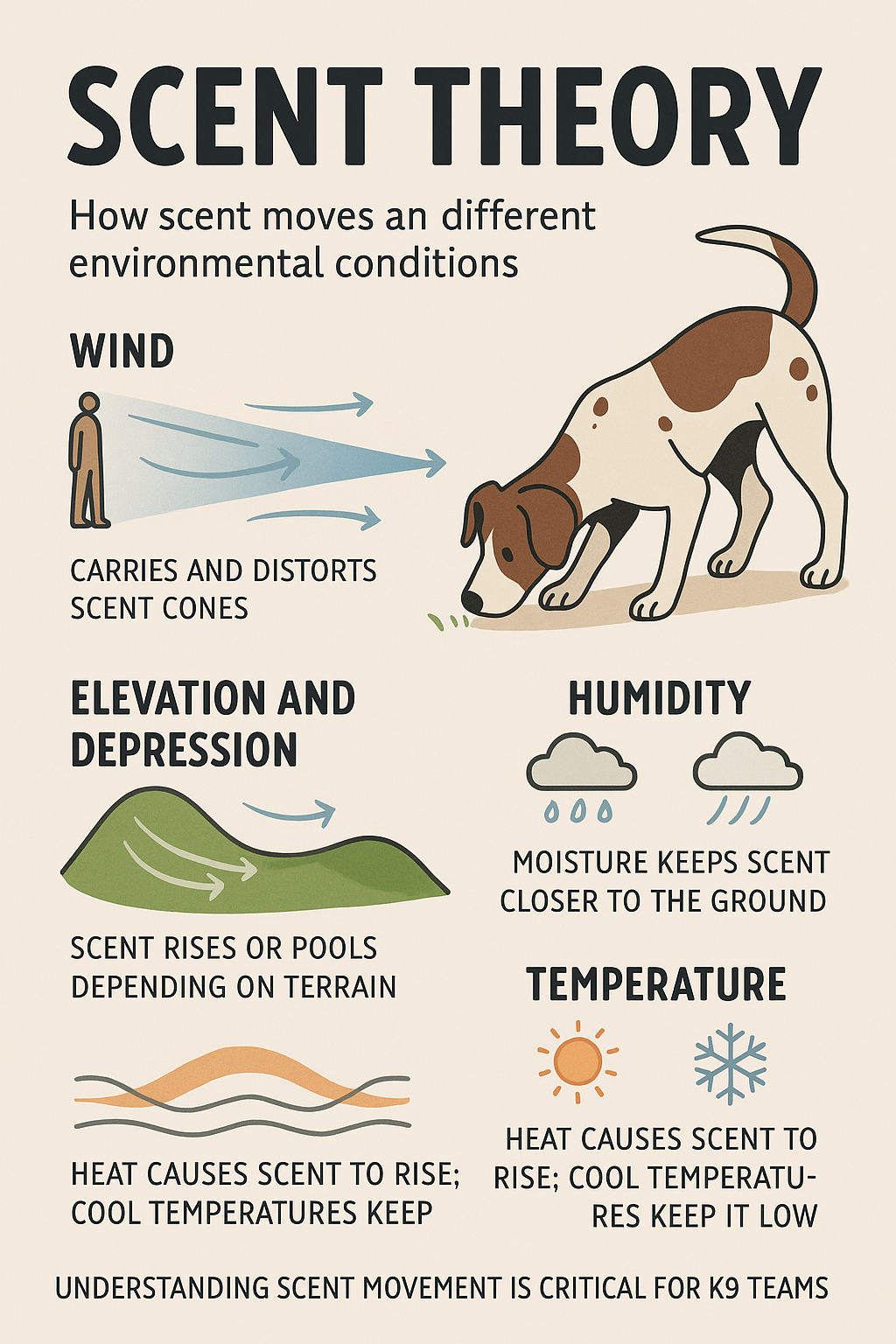
Understanding Scent Theory: Why It Matters for K9 Success
Partager
Scent work isn’t just about a dog’s nose, it’s about understanding how scent moves. Whether you’re working in urban tracking, wilderness SAR, detection, or nose work, knowing how environmental factors affect scent is critical to your team’s success. Scent theory bridges the gap between your dog’s incredible olfactory abilities and your ability to read the environment.
Let’s dive into how scent works, how it travels, and why this knowledge is one of the most valuable tools a handler can have.
How Dogs Smell: A Superpower in Action
Dogs experience the world through scent the way we experience it through sight. While humans have around 5 million scent receptors, most dogs have 200 million or more, Bloodhounds have over 300 million. Their noses are built to detect and interpret incredibly faint odour particles.
When a dog sniffs, air is separated inside the nose: some goes directly to the lungs, while the rest is directed to a special scent detection area called the olfactory epithelium. There, the real decoding begins. Dogs can even smell separately out of each nostril, allowing them to determine the direction a scent is coming from crucial when tracking or following an odour trail.
But even the best nose is only as good as the handler’s understanding of how scent moves in the environment.
Scent Isn’t Static: It Moves and Changes Constantly
Scent doesn’t sit still, it’s constantly moving, breaking apart, being lifted, pushed, diluted, or concentrated based on environmental factors. Understanding how those elements affect scent helps you set your dog up for success and interpret their behaviour more accurately.
Wind / Air Flow
Even indoors, air is always moving. Outside, wind is the main force carrying scent. A scent cone typically forms downwind from a source, widening as it travels. Strong wind can carry scent far away from the origin, but it can also lift it high above your dog’s head or push it into eddies and swirls.
Light breezes = predictable scent cone
Gusty or shifting wind = unpredictable scent behavior
🔍 Pro Tip: Use flagging tape, baby powder, or smoke pencils to see how scent is moving. This visual feedback helps you understand what your dog is actually working through.
Elevation and Terrain
Scent pools in low-lying areas like ditches and depressions, especially in cool conditions. Hills can block or funnel scent. High ground often has less scent than valleys.
💡 If your dog is struggling on a ridge, try working them downhill. You may find the scent is pooling below.
Humidity
Moisture helps hold scent particles closer to the ground and makes them easier for your dog to detect. Dry air, on the other hand, disperses scent more quickly and makes detection harder.
High humidity = scent sticks around longer
Low humidity = scent dries out and scatters
Temperature
Heat causes scent to rise; cool temperatures keep it low. On a hot day, scent might lift above your dog’s head, especially if the ground is radiating heat. In cooler temperatures, scent tends to settle close to the surface.
Hot pavement = scent might float up
Cool morning = scent stays low and dense
Indoors vs Outdoors
Air conditioning, heating, open windows, and even people walking past can all create micro air currents inside buildings. Just because you’re indoors doesn’t mean the air is still! Pay attention to vents, fans, doorways, and elevation changes.
Scent Theory in Action: Reading the Dog
Understanding how scent behaves helps you read your dog better. If your dog suddenly stops tracking, circles an area, or “casts” back and forth, they might not be confused they might be working through a difficult scent picture caused by swirling wind or scent pooling.
Sometimes what looks like “disinterest” is actually deep processing. Let them work it out.
Why Scent Theory Matters
Too often, handlers assume the dog “missed it,” when in reality the scent moved and the dog is adapting to that. By knowing how scent behaves, you become a better teammate. You can guide your dog toward likely scent areas, adjust expectations based on terrain, and avoid false negatives or handler-induced pressure.
-
Always work with the wind in mind. Start your dog downwind if possible.
-
Visualize the scent cone: narrow near the source, wide as it drifts.
-
Revisit scent theory often—it’s easy to forget how much it affects your dog’s success.
-
Let your dog work. Trust their nose, and use scent theory to interpret what they’re telling you.
When you understand the science of scent, your dog’s brilliant nose becomes an even more powerful tool. Scent work is a partnership and knowing how scent travels is the key to unlocking your team’s full potential.